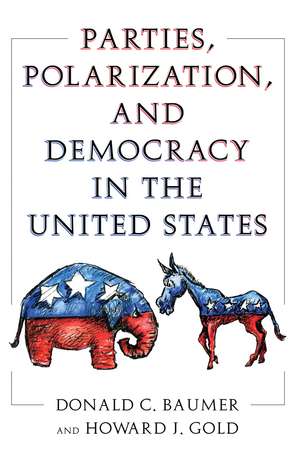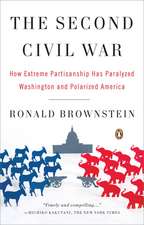Parties, Polarization and Democracy in the United States
Autor Donald C. Baumer, Howard J. Golden Limba Engleză Paperback – 30 iul 2010
| Toate formatele și edițiile | Preț | Express |
|---|---|---|
| Paperback (1) | 130.21 lei 43-57 zile | |
| Taylor & Francis – 30 iul 2010 | 130.21 lei 43-57 zile | |
| Hardback (1) | 247.40 lei 43-57 zile | |
| Taylor & Francis – 30 dec 2009 | 247.40 lei 43-57 zile |
Preț: 130.21 lei
Preț vechi: 170.51 lei
-24% Nou
Puncte Express: 195
Preț estimativ în valută:
24.92€ • 27.08$ • 20.95£
24.92€ • 27.08$ • 20.95£
Carte tipărită la comandă
Livrare economică 21 aprilie-05 mai
Preluare comenzi: 021 569.72.76
Specificații
ISBN-13: 9781594516689
ISBN-10: 1594516685
Pagini: 256
Dimensiuni: 152 x 229 x 15 mm
Greutate: 0.45 kg
Ediția:1
Editura: Taylor & Francis
Colecția Routledge
Locul publicării:Oxford, United Kingdom
ISBN-10: 1594516685
Pagini: 256
Dimensiuni: 152 x 229 x 15 mm
Greutate: 0.45 kg
Ediția:1
Editura: Taylor & Francis
Colecția Routledge
Locul publicării:Oxford, United Kingdom
Recenzii
“The authors present their thesis convincingly. Recommended.”
—CHOICE
“Donald C. Baumer and Howard J. Gold's Parties, Polarization, and Democracy in the United States provides a finely-grained and nuanced account of the evolution of popular partisanship in the United States through an exhaustive analysis of the full sequence of American National Election Studies from 1952 through 2008. It may not settle all the debates about partisan polarization and the ‘culture wars,’ but its data and analyses are required reading for anyone wanting to understand or participate in them.”
—Gary C. Jacobson, University of California—San Diego
“Baumer and Gold have made an important contribution to the literature on political parties and their relationship to democratic performance in America. Among the many attractive features of their work are that they integrate electoral and governing performance exceedingly well; that they make a clear case for partisan and ideological sorting as the important dynamic at the voter level; and that the coherence of the two parties, the robust debate in which they engage, and their fealty to position and thus to their supporting coalition are positive signs for American democracy. I especially like their claim that American parties today stand at least as distinctively, and apparently actually more distinctively, as their peers in Australia, Britain, and Canada, and that in the 2004 and 2008 elections, ideology has come to rival partisanship as a determinant of vote choice in the public. All in all, they make a strong case for the centrality of political parties for democratic governance.”
—John Aldrich, Duke University
“It has always been fashionable to disparage the role of political parties in America. However, in spite of all the changes in American life—from television to the Internet— that were supposed to make them obsolete, political parties persist in having meaning for the voting public. Baumer and Gold have done a masterful job of assembling the data that prove, once again, that political parties matter.”
—Elaine C. Kamarck, John F. Kennedy School of Government, Harvard University, author of Primary Politics: How Presidential Candidates Have Shaped the Modern Nominating System
—CHOICE
“Donald C. Baumer and Howard J. Gold's Parties, Polarization, and Democracy in the United States provides a finely-grained and nuanced account of the evolution of popular partisanship in the United States through an exhaustive analysis of the full sequence of American National Election Studies from 1952 through 2008. It may not settle all the debates about partisan polarization and the ‘culture wars,’ but its data and analyses are required reading for anyone wanting to understand or participate in them.”
—Gary C. Jacobson, University of California—San Diego
“Baumer and Gold have made an important contribution to the literature on political parties and their relationship to democratic performance in America. Among the many attractive features of their work are that they integrate electoral and governing performance exceedingly well; that they make a clear case for partisan and ideological sorting as the important dynamic at the voter level; and that the coherence of the two parties, the robust debate in which they engage, and their fealty to position and thus to their supporting coalition are positive signs for American democracy. I especially like their claim that American parties today stand at least as distinctively, and apparently actually more distinctively, as their peers in Australia, Britain, and Canada, and that in the 2004 and 2008 elections, ideology has come to rival partisanship as a determinant of vote choice in the public. All in all, they make a strong case for the centrality of political parties for democratic governance.”
—John Aldrich, Duke University
“It has always been fashionable to disparage the role of political parties in America. However, in spite of all the changes in American life—from television to the Internet— that were supposed to make them obsolete, political parties persist in having meaning for the voting public. Baumer and Gold have done a masterful job of assembling the data that prove, once again, that political parties matter.”
—Elaine C. Kamarck, John F. Kennedy School of Government, Harvard University, author of Primary Politics: How Presidential Candidates Have Shaped the Modern Nominating System
Cuprins
Chapter 1 Political Part Ies in the Twenty-First Century; Chapter 2 Part Ies and the Electorate I: Images of the Part Ies; Chapter 3 Part Ies and the Electorate II: The Dynamics of Party Polarization; Chapter 4 The Midterm Elections of 1994 and 2006; Chapter 5 Part Ies in Power: Congress, Presidents, Part Isanship, and Gridlock; Chapter 6 Political Part Ies in Anglo-America; Chapter 7 Looking Backward and Forward: The Election of 2008 and the Future of American Politics;
Notă biografică
Authored by Baumer, Donald C.; Gold, Howard J.
Descriere
As evidenced in the 2008 elections and the transition to a new era of Democratic governance, one of the most important developments in American politics in recent years has been the resurgence of political parties















